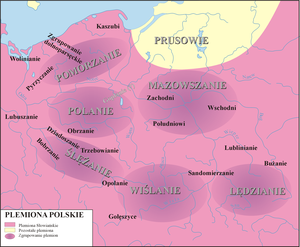Polish tribes

 |
| Prehistory and protohistory of Poland |
|---|
| Chronology |
|
Antiquity Early Middle Ages |
| Topics |
|
Lusatian culture Biskupin Oksywie culture Wielbark culture Przeworsk culture Polish tribes |
"Polish tribes" is a term used sometimes to describe the
In about 850 AD a list of peoples was written down by the
The most important tribes who were conquered by
Ethnonym
The name "Poland" is derived from the most powerful of the tribes — the
Religion
The Polish tribes were
Organization
The tribes were organized on the basis of kinship groups. A tribe's territory was divided into opoles, which constituted a group of neighboring settlements.
Most members of a particular tribe were yeoman peasants, although a small group of aristocrats (nobiles or potentiores) was usually present.
Tribes
The following is the list of Polish tribes that inhabited the lands of Poland in the early Middle Ages, at the beginning of the Polish state. They shared fundamentally common culture and language and together they formed what is now Polish ethnicity and the culture of Poland. This process is called ethnic consolidation in which several ethnic communities of kindred origin and cognate languages, merge into a single one.[4]
The following Slavic tribes are considered as Polish:
- Polans
- Pomeranians
- Pyrzyczanie
- Wolinianie
- Goplans
- Lendians
- Masovians
- Vistulans
- Silesians
- Bieżuńczanie
- Bobrzanie
- Dziadoszanie
- Golęszyce
- Lubuszanie
- Opolanie
- Ślężanie
- Trzebowianie
See also
References
- ^ John Blacking, Anna Czekanowska, Polish Folk Music: Slavonic Heritage - Polish Tradition - Contemporary Trends, Cambridge University Press, 2006, p. 3,
- ^ Gloger, Zygmunt. "Plemiona lechickie i ich ziemie".
- ISBN 311080770X, 9783110807707 Google Books
